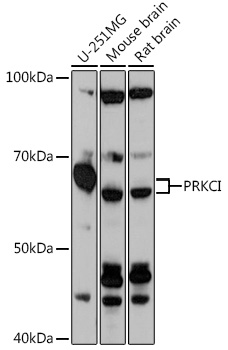Cell Biology Antibodies 18
Anti-PRKCI Antibody (CAB18348)
- SKU:
- CAB18348
- Product Type:
- Antibody
- Reactivity:
- Human
- Reactivity:
- Mouse
- Reactivity:
- Rat
- Host Species:
- Rabbit
- Isotype:
- IgG
- Research Area:
- Cell Biology
Description
| Antibody Name: | Anti-PRKCI Antibody |
| Antibody SKU: | CAB18348 |
| Antibody Size: | 20uL, 50uL, 100uL |
| Application: | WB |
| Reactivity: | Human, Mouse, Rat |
| Host Species: | Rabbit |
| Immunogen: | Recombinant protein of human PRKCI. |
| Application: | WB |
| Recommended Dilution: | WB 1:500 - 1:2000 |
| Reactivity: | Human, Mouse, Rat |
| Positive Samples: | U-251MG, Mouse brain, Rat brain |
| Immunogen: | Recombinant protein of human PRKCI. |
| Purification Method: | Affinity purification |
| Storage Buffer: | Store at -20°C. Avoid freeze / thaw cycles. Buffer: PBS with 0.02% sodium azide, 50% glycerol, pH7.3. |
| Isotype: | IgG |
| Sequence: | Email for sequence |
| Gene ID: | 5584 |
| Uniprot: | P41743 |
| Cellular Location: | |
| Calculated MW: | 68kDa |
| Observed MW: | 68kDa |
| Synonyms: | PKCI, DXS1179E, nPKC-iota, PRKCI |
| Background: | This gene encodes a member of the protein kinase C (PKC) family of serine/threonine protein kinases. The PKC family comprises at least eight members, which are differentially expressed and are involved in a wide variety of cellular processes. This protein kinase is calcium-independent and phospholipid-dependent. It is not activated by phorbolesters or diacylglycerol. This kinase can be recruited to vesicle tubular clusters (VTCs) by direct interaction with the small GTPase RAB2, where this kinase phosphorylates glyceraldehyde-3-phosphate dehydrogenase (GAPD/GAPDH) and plays a role in microtubule dynamics in the early secretory pathway. This kinase is found to be necessary for BCL-ABL-mediated resistance to drug-induced apoptosis and therefore protects leukemia cells against drug-induced apoptosis. There is a single exon pseudogene mapped on chromosome X. |
| UniProt Protein Function: | PKCI: an AGC protein kinase of the PKC family. A calcium-independent, phospholipid-dependent atypical protein kinase C. Is not activated by phorbolesters or diaglycerol. May play role in the secretory response to nutrients. Involved in cell polarization processes and the formation of epithelial tight junctions. Predominantly expressed in lung and brain, but also expressed at lower levels in many tissues including pancreatic islets. |
| UniProt Protein Details: | Protein type:Oncoprotein; Protein kinase, AGC; Protein kinase, Ser/Thr (non-receptor); Kinase, protein; Cell adhesion; EC 2.7.11.13; Cell development/differentiation; Motility/polarity/chemotaxis; Tumor suppressor; AGC group; PKC family; Iota subfamily Chromosomal Location of Human Ortholog: 3q26.3 Cellular Component: Golgi membrane; microtubule cytoskeleton; intercellular bridge; tight junction; protein complex; leading edge; cytoplasm; apical plasma membrane; plasma membrane; cytosol; nucleus; endosome Molecular Function:protein serine/threonine kinase activity; protein domain specific binding; protein binding; protein kinase C activity; metal ion binding; phospholipid binding; ATP binding; protein kinase activity Biological Process: intercellular junction assembly and maintenance; secretion; cell migration; nerve growth factor receptor signaling pathway; establishment of apical/basal cell polarity; actin filament organization; cytoskeleton organization and biogenesis; protein amino acid phosphorylation; activation of NF-kappaB transcription factor; establishment and/or maintenance of epithelial cell polarity; vesicle-mediated transport; positive regulation of glucose import; eye photoreceptor cell development; cellular response to insulin stimulus; negative regulation of neuron apoptosis; Golgi vesicle budding; protein targeting to membrane; negative regulation of apoptosis |
| NCBI Summary: | This gene encodes a member of the protein kinase C (PKC) family of serine/threonine protein kinases. The PKC family comprises at least eight members, which are differentially expressed and are involved in a wide variety of cellular processes. This protein kinase is calcium-independent and phospholipid-dependent. It is not activated by phorbolesters or diacylglycerol. This kinase can be recruited to vesicle tubular clusters (VTCs) by direct interaction with the small GTPase RAB2, where this kinase phosphorylates glyceraldehyde-3-phosphate dehydrogenase (GAPD/GAPDH) and plays a role in microtubule dynamics in the early secretory pathway. This kinase is found to be necessary for BCL-ABL-mediated resistance to drug-induced apoptosis and therefore protects leukemia cells against drug-induced apoptosis. There is a single exon pseudogene mapped on chromosome X. [provided by RefSeq, Jul 2008] |
| UniProt Code: | P41743 |
| NCBI GenInfo Identifier: | 239938658 |
| NCBI Gene ID: | 5584 |
| NCBI Accession: | P41743.2 |
| UniProt Secondary Accession: | P41743,Q8WW06, D3DNQ4, |
| UniProt Related Accession: | P41743 |
| Molecular Weight: | 68,262 Da |
| NCBI Full Name: | Protein kinase C iota type |
| NCBI Synonym Full Names: | protein kinase C, iota |
| NCBI Official Symbol: | PRKCI |
| NCBI Official Synonym Symbols: | PKCI; DXS1179E; nPKC-iota |
| NCBI Protein Information: | protein kinase C iota type; PRKC-lambda/iota; aPKC-lambda/iota; atypical protein kinase C-lambda/iota |
| UniProt Protein Name: | Protein kinase C iota type |
| UniProt Synonym Protein Names: | Atypical protein kinase C-lambda/iota; PRKC-lambda/iota; aPKC-lambda/iota; nPKC-iota |
| Protein Family: | Protein kinase |
| UniProt Gene Name: | PRKCI |
| UniProt Entry Name: | KPCI_HUMAN |







